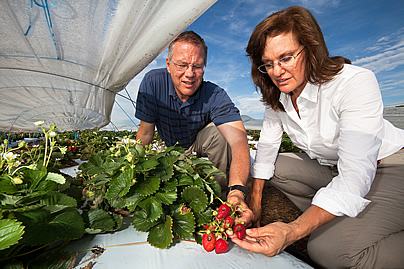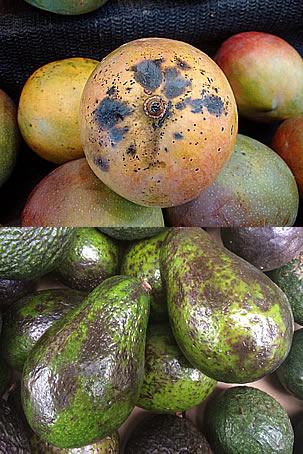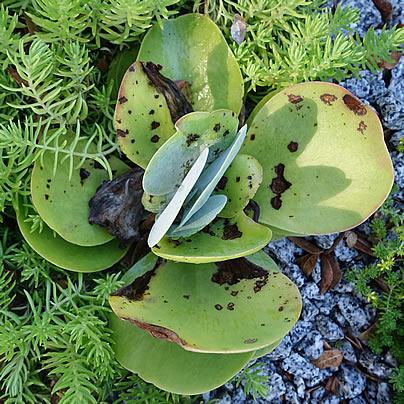Anthracnose is one of the most significant diseases affecting cultivated plants. It causes billions of dollars in annual losses due to damage in large crops (soybeans, tomatoes, bell peppers, eggplants, peppers, strawberries), orchards (mangoes, oranges, guavas, avocados, cashews, grapes, bananas, papayas, passion fruits, nectarines, apples), forests (oaks, dogwoods, thuja, walnuts, almond trees) and ornamental plant nurseries.
It is primarily caused by fungi of the genus Colletotrichum, especially the species Colletotrichum gloeosporioides, which affects various plant species. Other etiological agents involved in the development of anthracnose include Sphacelloma spp, Marssonina spp, Gloeosporium spp, Coniothyrium fuckelii, and Elsinoe ampelina, among others.

Anthracnose appears under favorable environmental conditions, such as mild climate with temperatures between 68°F and 86°F (20°C and 30°C) and high humidity. Weak, poorly rooted, or malnourished plants, especially those deficient in potassium and calcium, are more susceptible. Under these conditions, the fungus can spread and grow rapidly, especially if there is abundant organic matter and poor ventilation.
This is why its occurrence is rare in arid regions, such as Northeast Brazil or Israel. Transmission occurs through rain or irrigation water, but can also be through wind and contaminated pruning tools, as well as insects and other pests. Although it infects plants, it is also a saprophytic fungus, meaning it can survive in the environment on dead plant debris, such as fallen leaves and fruits, waiting for an opportunity to affect living plants again.
Like many other fungal, bacterial, or viral plant diseases, anthracnose produces somewhat nonspecific symptoms, so precise diagnosis can only be made in a laboratory. Nevertheless, an experienced agronomist can diagnose and treat the disease efficiently. The most common symptoms are rounded spots, brown, gray, or black in color, on leaves, fruits, stalks, etc. These spots often have a yellow halo (chlorosis) around them, with a depressed and necrotic center, showing orange or pink filaments, which are the fungus’s reproductive structures where spores are produced (Acervuli).
The first signs usually appear on the edges of leaves or near veins, where water tends to accumulate. With the growth and merging of several spots, the structure, whether it’s a leaf, shoot, branch, flower, or fruit, can die and fall off prematurely. In woody plants, anthracnose can form real cankers, which are abnormal growths of the bark over necrotic areas on the trunk, giving trees an unsightly appearance and gradually weakening them.

Ornamental Plants most commonly affected by Anthracnose:
- Agapanthus
- Anthurium
- Areca Palm
- Aspidistra
- Aloe Vera
- Red Ginger
- Begonias
- Cacti
- Kalanchoe
- Sago Palm
- Cyclamen
- Clusia
- Dumb Cane
- Crinum
- Dracaena
- Snake Plant
- Bird of Paradise
- Ficus Trees
- Philodendrons
- Flamboyant Tree
- Heliconias
- Hydrangea
- Yucca
- Lily
- Lupine
- Mandevilla
- Golden Dewdrop
- Desert Rose
- Roses
- Elephant’s Ear
- Annatto
- Zamioculcas
Prevention and Control:
Several measures can be taken to prevent and control the occurrence of anthracnose in gardens or commercial crops. Many of these also serve as prevention for a multitude of other plant diseases and pests. Here’s how to keep your plants free from this dreaded disease.

- When acquiring new plants, keep them in quarantine, away from other plants;
- Always purchase healthy plants, as well as seeds and bulbs.
- Prefer varieties known to be resistant to anthracnose, especially important for orchards.
- Maintain good spacing between potted plants. For orchids, for example, it’s recommended to keep a hand’s width distance between the leaves of plants. Similarly, overly dense orchards promote the disease in fruit trees.
- Perform pruning for cleaning and ventilation, both in fruit trees and susceptible ornamental plants. Overcrowded Heliconias, as well as Bird of Paradise plants, are commonly affected.
- Water plants early in the morning, allowing them to dry quickly, and preventing water accumulation.
- Dispose of pruning remains, fallen leaves, and fruits, so they don’t serve as a source of infection for the plants; keep the garden clean, especially in winter and during humid periods (rainy seasons).
- Keep greenhouses and orchid houses well ventilated, so the plants don’t stay wet for too long after spraying.
- In case of suspicious spots, quickly cut off the affected parts with a good margin of safety. It’s advisable to apply a copper-based paste or a mixture of cinnamon with mineral oil to the wound, to protect and promote healing. By eliminating the infection early, the spread of the disease is prevented.
- Separate affected plants from others and gradually increase ventilation and light exposure.
- In special situations, such as large infections or plants of high commercial value, applications of fungicides, either contact or systemic, like copper oxychloride or mancozeb for example, can be performed, always under the guidance of a responsible agricultural engineer.


